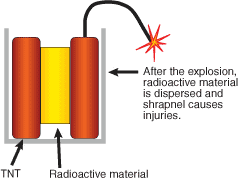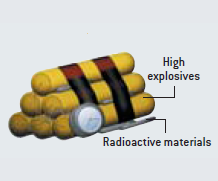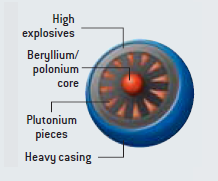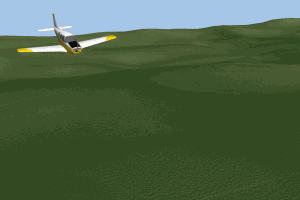Radiological Dispersal Devices (RDDs)
- Radiological Dispersal Devices (RDDs)
- Potential Isotopes Used in RDDs
- Potential RDD Effects
- Guidance about Initial Protective Actions after an RDD explosion
- Other Guidance about Radiation Control Zones and Perimeters after a Radiological incident
- Communicating with the General Public after an RDD
- References
- See also:
- Radiological Dispersal Device (RDD) Response Guidance, Planning for the first 100 Minutes (PDF - 2.68 MB) (DHS, NUSTL, NNSA, FEMA, November 2017)
- Nuclear/Radiological Incident Annex to the Response and Recovery Federal Interagency Operations Plan (PDF - 3.38 MB) (US Government Interagency, 2016)
- Emergency Worker Exposure Guidelines in the Early Phase of an Incident
- Protective Action Guides: Nomenclature
- Radiation Detection Devices
- Decontamination
- Personal Protective Equipment
- Responder Willingness to Serve During Radiation Disasters
Radiological Dispersal Devices (RDDs):
Dirty Bomb, Other Dispersal Methods
- Radiological Dispersal Device (RDD) is any device that causes the purposeful dissemination of radioactive material without a nuclear detonation.
- Dispersion methods can be
-
"Dirty Bomb" = Explosive method of dispersion (See Figure 1)
- Explosion produces radioactive and nonradioactive shrapnel and radioactive dust
-
Explosion causes
- Radiation contamination, commonly (Animations)
- Radiation exposure only in certain circumstances (Animations)
- Physical injury
- Burns
- Panic, fear
Figure 1. Dirty Bomb: Radiological Dispersal Device Using Explosive


Figure 2. Difference between "Dirty Bomb" and "Fission Bomb" - Illustration

Dirty bomb:- Explosives combined with radioactive materials
- Detonation vaporizes and aerosolizes radioactive material and propels it into the air dispersing and contaminating the air and affected surfaces with radioactive isotopes.
- Not a nuclear detonation
- Inhalation and skin contamination are concerns met with removal of contaminated clothing, washing of skin, and potentially use of isotope specific decorporation agents (i.e. DTPA, etc) to remove internalized radioactive material.

Fission bomb: one example- Caused by a mass-limited but uncontrolled nuclear chain reaction with uranium-235 or plutonium-239
- Fission weapons have uranium-235 or plutonium-239 surrounded by conventional explosives designed to implode toward a central sphere of the isotopes to force criticality
- Initiation of a centrally directed implosion of conventional explosives around the uranium or plutonium produces a compressive shock wave directed toward the central sphere. The weapon contains pellets of beryllium/polonium which increase the flux (incursion) of neutrons which enhance the ability to create "criticality",ie., the initiation of U-235 or Pu-239 chain reactions to fission (splitting) and release of massive nuclear sourced energies resulting in a nuclear explosion
- Other Dispersal Methods
- Passive or active dispersion of unsealed radioactive sources, e.g., deposit in soil or water, drop from airborne device (See Figure 3)
- Radioactive sources can be solid, aerosol, gas, or liquid
- Contamination of people may occur via air, water, soil, or food

-
"Dirty Bomb" = Explosive method of dispersion (See Figure 1)
- Explosive RDDs cannot cause mass casualties on the scale of a nuclear explosion. All or most fatalities or injuries will probably due to explosion itself.
- While large numbers of people in a densely populated area around the detonation of an RDD might become contaminated and require decontamination, few if any will be contaminated to a level that requires medical treatment.
- Local health authorities will have to assess the persons who were very close to the point of release for the need for medical intervention.
- The health and environmental consequences from RDDs, will depend on
- The design of the device
- Type and quantity of radioactive material
- The pattern of dispersion following the release
- RDDs may affect
- Small, localized areas (e.g., a street, single building, or city block)
- Large areas, up to several square miles, depending on the nature of the dispersion and the amount and type of radioactive material
- Other hazards may also be present
- Fire, smoke, shock, shrapnel (from an explosion)
- Industrial chemicals
- Secondary device
- Radioactive decontamination of persons and areas affected may be required.
- Radiological Dispersal Device (RDD) Response Guidance, Planning for the first 100 Minutes (PDF - 2.68 MB) (DHS, NUSTL, NNSA, FEMA, November 2017)
- Majewski M, Nestler K, Veit DA, Diekmeyer B, Waldeck S, Port M, Becker BV. Detection of Embedded Low-Level Radioactive Shrapnels after the Explosion of a Radiological Dispersal Device in Radiological Emergency Imaging. Health Phys. 2020 Jan 7. [PubMed Citation]
- Runge JW, Buddemeier BR. Explosions and radioactive material: a primer for responders. Prehosp Emerg Care. 2009 Oct-Dec;13(4):407-19. [PubMed Citation]
- Responding to an RDD / RED Emergency: the HHS Playbook, guidance for executive decision makers within the Department of Health and Human Services (HHS) in the event of an actual radiological terrorist attack in a U.S. city. (HHS/ASPR, April 2010)
- Musolino SV, Harper FT, Buddemeier B, Brown M, Schlueck R. Updated Emergency Response Guidance for the First 48 H after the Outdoor Detonation of an Explosive Radiological Dispersal Device. Health Phys 2013;105(1);65-73.
- Harper FT, Musolino SV, Wente WB. Realistic radiological dispersal device hazard boundaries and ramifications for early consequence management decisions. Health Phys. 2007 Jul;93(1):1-16. [PubMed Citation]
- Smith JM, Ansari A, Harper FT. Hospital management of mass radiological casualties: reassessing exposures from contaminated victims of an exploded radiological dispersal device. Health Phys. 2005 Nov;89(5):513-20. [PubMed Citation]
- Musolino SV, Harper FT. Emergency Response Guidance for the First 48 Hours after the Outdoor Detonation of an Explosive Radiological Device. Health Physics 2006 Apr;90(4):377-85. [PubMed Citation]
- Management of Terrorist Events Involving Radioactive Material (NCRP Report No. 138), National Council on Radiation Protection and Measurements, Bethesda, MD, 2001.
- Management of Persons Contaminated with Radionuclides: Handbook (NCRP Report No. 161, Vol. I), National Council on Radiation Protection and Measurements, Bethesda, MD, 2008, Settings in Which Contamination Incidents May Occur (pp. 393-396).
- Handbook for responding to a radiological dispersal device first responder's guide — the first 12 hours (Conference of Radiation Control Program Directors, Inc., September 2006)
- Radiological Dispersal Device (PDF - 2.34 MB) (Human Health Fact Sheet, Argonne National Laboratory, August 2005)
- FAQs About Dirty Bombs (HHS/CDC, 05/10/2006)
- Fact Sheet on Dirty Bombs (NRC)
- Radiological Attack — Radiological Dispersal Devices (PDF - 127 KB) (The California Emergency Medical Services Authority)
Potential Isotopes Used in RDDs
RDD Isotope Fact Sheets |
||||||
Isotope |
More Information: Fact Sheets |
|||||
|---|---|---|---|---|---|---|
EPA*** |
||||||
Americium-241 |
||||||
Californium-252 |
||||||
Cesium-137 |
||||||
Cobalt-60 |
||||||
Iridium-192 |
||||||
Plutonium-238 |
||||||
Polonium-210 |
||||||
Radium-226 |
||||||
Strontium-90 (Sr-90/Y-90) |
||||||
* HHS/Centers for Disease Control and Prevention | ||||||
See also:
|
||||||
Basic Radiological Properties of RDD Isotopes
Basic Radiological Properties of Nine Key Radionuclides for RDDs | ||||||
|---|---|---|---|---|---|---|
Isotope |
Half-Life |
Specific Activity |
Decay Mode |
Radiation Energy (MeV) |
||
Alpha |
Beta |
Gamma |
||||
Americium-241 |
430 |
3.5 |
α |
5.5 |
0.052 |
0.033 |
Californium-252 |
2.6 |
540 |
α (SF, EC) |
5.9 |
0.0056 |
0.0012 |
Cesium-137 |
30 |
88 |
β, IT |
- |
0.19, 0.065 |
0.60 |
Cobalt-60 |
5.3 |
1,100 |
β |
- |
0.097 |
2.5 |
Iridium-192 |
0.2 (74 d) |
9,200 |
β, EC |
- |
0.22 |
0.82 |
Plutonium-238 |
88 |
17 |
α |
5.5 |
0.011 |
0.0018 |
Polonium-210 |
0.4 (140 d) |
4,500 |
α |
5.3 |
- |
- |
Radium-226 |
1,600 |
1.0 |
α |
4.8 |
0.0036 |
0.0067 |
Strontium-90 |
29 |
140 |
β |
- |
0.20, 0.94 |
- |
SF = spontaneous fission; IT = isomeric transition; EC = electron capture. A hyphen means not applicable. The radiation energies for cesium-137 include the contributions of barium-137 metastable (Ba-137m), and those for strontium-90 include the contributions of yttrium-90. | ||||||
Potential RDD Effects
- Contamination: Diagnose/Manage
- Exposure: Diagnose/Manage Acute Radiation Syndrome
- Burn Triage and Treatment
- Panic, fear
Guidance about Initial Protective Actions after an RDD Explosion
- Radiological Dispersal Device (RDD) Response Guidance, Planning for the first 100 Minutes (PDF - 2.68 MB) (DHS, NUSTL, NNSA, FEMA, November 2017)
- Delineates missions and tactics that should be executed by first responders and local response agencies in the first 100 minutes of a response to an outdoor explosive radiological dispersal device1 (RDD) detonation,
- Recommendations are based on realistic estimates of the possible consequences.
- Includes recommendations for equipment requirements, including personal protective equipment (PPE), and public messaging.
- Scientific Experiments to Operational Tactics for the First 100 Minutes After an Outdoor Explosive Radiological Dispersal Device — Dr. Stephen Musolino’s lecture at the 2016 Annual NCRP Meeting, Bethesda, MD. (YouTube 29:04)

- Musolino SV, Harper FT, Buddemeier B, Brown M, Schlueck R. Updated Emergency Response Guidance for the First 48 H after the Outdoor Detonation of an Explosive Radiological Dispersal Device. Health Phys 2013;105(1);65-73.
- See photo of radioactive dispersal from an experimental RDD explosion.
- See diagram of hypothetical dispersal possibilities.
- This important paper updates an earlier version from 2006. It uses experimental and modeling data to provide guidance about the "predicted range of radioactive ballistic fragments that could endanger first responders and the public."
- See diagram of recommended initial Protective Action Zones from this paper.
- Before definitive environmental radiation measurements are performed, the authors recommend that incident managers establish an empiric "initial hazard boundary corresponding to the potential for acute health effects" of "250 meters in all directions from the site of the incident". This is smaller than the 500 meter boundary recommended in the authors' previous paper from 2006. Subsequent actual measurements may alter these perimeter recommendations.
- "This boundary is independent of the total activity of the radioactive material." It reflects confidence that debris from radioactive ballistic fragments would likely fall within 250 meters of the explosion.
- The authors also recommend a "wider initial Shelter-in-Place Zone, 500 meters in all direction from the incident site and 2,000 meters downwind." This will diminish the chance of "encountering the undiluted aerosol plume and hence an acute exposure from inhalation (if the device generated significant aerosol, shine from a highly radioactive fragment, or injury from the detonation of a secondary improvised explosive device".
- "Persons who are outside, or in s significantly damaged or 'smoky' building, should immediately move to the nearest robust, intact structure; if the event is a small one, people should move out of the immediate area provided that there is a clear path but still take shelter in an intact nearby building."
- "In both cases, people should remain in the shelter until the local officials direct them to proceed to an uncontaminated evacuation route, and downwind of the detonation site, sheltering should be extended out to 2,000 meters to avoid a lower level exposure to the aerosol plume."
- The paper also discusses aerosol dispersal.
- "The assessment of the potential range and effects of dispersal from small particles as aerosol remains unchanged from guidance issues in 2006."
- The article provides more detailed guidance about this kind of complex radioactive aerosol dispersal from various kinds of scenarios, and how to provide response guidance based on these measurements.
- The paper also provides detailed guidance for how to take measurements for evaluating the level and location of the radiation contamination after an RDD explosion.
Other Guidance about Radiation Control Zones and Perimeters after a Radiological Incident
- Scientific Experiments to Operational Tactics for the First 100 Minutes after an Outdoor Explosive Radiological Dispersal Device Presented by Dr. Stephen Musolino at the April 2016 NCRP annual meeting. (YouTube - 29:04 minutes)

- This outstanding video will be exceptionally helpful to local responders, with explanations of when, where, and how to measure radiation in the environment to characterize radiation levels after an incident, create response zones, and protect themselves and the public.
- The ongoing project reflects continuing study of explosive RDDs by Dr. Fred Harper of Sandia Lab and Dr. Musolino of Brookhaven Lab.
- Additional guidance, based on this work, will be published soon.
- A variety of professional organizations and government entities have proposed Radiation Control Zones and Perimeters after a radiological incident based on actual measurements of environmental radiation levels.
- These zones are recommended to help protect responders and the public, and they are often linked to Protective Actions.
- Note that the labels of the zones, the radiation levels circumscribed by the boundaries, and the colors assigned to the zones are not the same for each organization.
- This table and its links to diagrams provide examples of several groups' proposed Radiation Control Zones for Radiological Incidents and show the many differences among the agencies.
- Responders should know and adhere to the nomenclature used by their agency.
- Note that zone designations for nuclear incidents are likely to be different from zone designations for Radiological Incidents.
- Managing a Bombing Incident: First Bomb App (DHS):
Communicating with the General Public after an RDD
- Dirty Bomb or Radiological Dispersal Device (HHS/CDC Infographic)
- Bass SB, Gordon TF, Maurer L, Greener J, Mora G, Ruggieri D, Wolak C, Parvanta C. How Do Low-Literacy Populations Perceive "Dirty Bombs"? Implications for Preparedness Messages. Health Secur. 2016 Sep-Oct;14(5):331-44. [PubMed Citation]
- Rogers MB, Amlot R, Rubin GJ. The Impact of communication materials on public responses to a radiological dispersal device (RDD) attack. Biosecur Bioterror. 2013 Mar;11(1):49-58. [PubMed Citation]
References
Basic Information about RDDs
- Radiological Dispersal Device (RDD) Response Guidance, Planning for the first 100 Minutes (PDF - 2.68 MB) (DHS, NUSTL, NNSA, FEMA, November 2017)
- Response and Recovery Knowledge Product: Key Planning Factors for Recovery from a Radiological Terrorism Incident (PDF - 7.48 MB) (DHS/FEMA, September 2012)
- Radiological Attack: Dirty Bombs and Other Devices (PDF - 591 KB) (National Academies and DHS, 2004)
- Runge JW, Buddemeier BR. Explosions and radioactive material: a primer for responders. Prehosp Emerg Care. 2009 Oct-Dec;13(4):407-19. [PubMed Citation]
- Fact Sheet on Dirty Bombs (NRC)
- Dirty Bombs (NYC Department of Health and Mental Hygiene)
- Frequently Asked Questions (FAQs) about Dirty Bombs (HHS/CDC, 2006)
- Rump A, Becker B, Eder S, Lamkowski A, Abend M, Port M. Medical management of victims contaminated with radionuclides after a "dirty bomb" attack. Mil Med Res. 2018 Aug 6;5(1):27. [PubMed Citation]
US National Laboratory Guidance
- Key papers outlining advice the US government is giving to state and local agencies on how to protect responders and the public from the radiological environment after an RDD incident
- Musolino SV, Harper FT, Buddemeier B, Brown M, Schlueck R. Updated Emergency Response Guidance for the First 48 H after the Outdoor Detonation of an Explosive Radiological Dispersal Device. Health Phy 2013;105(1);65-73.
- Responding to a Radiological or Nuclear Terrorism Incident: A Guide for Decision Makers (PDF - 1.61 MB) (NCRP Report No. 165), National Council on Radiation Protection and Measurements, Bethesda, MD, 2010.
- Harper FT, Musolino SV, Wente WB. Realistic radiological dispersal device hazard boundaries and ramifications for early consequence management decisions. Health Phys. 2007 Jul;93(1):1-16. [PubMed Citation]
- Musolino SV, Harper FT. Emergency Response Guidance for the First 48 Hours after the Outdoor Detonation of an Explosive Radiological Device. Health Physics 2006 Apr;90(4):377-85. [PubMed Citation]
- Smith JM, Ansari A, Harper FT. Hospital management of mass radiological casualties: reassessing exposures from contaminated victims of an exploded radiological dispersal device. Health Phys. 2005 Nov;89(5):513-20. [PubMed Citation]
- Radiological Dispersal Device (PDF - 2.34 MB) Human Health Fact Sheet, Argonne National Laboratory, August 2005
Experimental Evidence Describing the Consequences of Exploding an RDD Outdoors
- Health Physics, Volume 110(5) pgs. 399-550 May 2016
- Eleven papers on various aspects of the consequences of detonations, including the following summaries
- Green AR, Erhardt L, Lebel L, Duke MJ, Jones T, White D, Quayle D. Overview of the Full-scale Radiological Dispersal Device Field Trials. Health Phys. 2016 May;110(5):403-17. [PubMed Citation]
- Blumenthal DJ, Musolino SV. International Outdoor Experiments and Models for Outdoor Radiological Dispersal Devices. Health Phys. 2016 May;110(5):401-2. [PubMed Citation]
- Eleven papers on various aspects of the consequences of detonations, including the following summaries
HHS Guidance
- Responding to an RDD / RED Emergency: the HHS Playbook, guidance for executive decision makers within the Department of Health and Human Services (HHS) in the event of an actual radiological terrorist attack in a U.S. city. (HHS/ASPR, April 2010)
- FAQs About Dirty Bombs (HHS/CDC, 05/10/2006)
NCRP Guidance
- Population Monitoring and Radionuclide Decorporation Following a Radiological or Nuclear Incident (NCRP Report No. 166), National Council on Radiation Protection and Measurements, Bethesda, MD, 2011.
- Responding to a Radiological or Nuclear Terrorism Incident: A Guide for Decision Makers (PDF - 1.61 MB) (NCRP Report No. 165), National Council on Radiation Protection and Measurements, Bethesda, MD, 2010.
- Management of Persons Contaminated with Radionuclides: Handbook (NCRP Report No. 161, Vol. I), National Council on Radiation Protection and Measurements, Bethesda, MD, 2008, Settings in Which Contamination Incidents May Occur (pp. 393-396).
- Key Elements of Preparing Emergency Responders for Nuclear and Radiological Terrorism (NCRP Commentary No. 19), National Council on Radiation Protection and Measurements, Bethesda, MD, December 2005. Purchase required.
- Management of Terrorist Events Involving Radioactive Material (NCRP Report No. 138), National Council on Radiation Protection and Measurements, Bethesda, MD, 2001.
Response Guidance for Local Responders and Health Care Entities
- Handbook for responding to a radiological dispersal device first responder's guide — the first 12 hours (Conference of Radiation Control Program Directors, Inc., September 2006)
- NYC Hospital Guidance for Responding to a Contaminating Radiation Incident (PDF - 1.95 MB) (New York City Department of Health and Mental Hygiene, Healthcare Emergency Preparedness Program, April 2009)
- Radiological Attack — Radiological Dispersal Devices (PDF - 127 KB) (The California Emergency Medical Services Authority)
- Population Monitoring in Radiation Emergencies: A Guide for State and Local Public Health Planners, Second Edition, April 2014. (PDF - 1.02 MB) (HHS/CDC)
- Manual for First Responders to a Radiological Emergency, page 12, (PDF - 2.2 MB) (CTIF, IAEA, PAHO, WHO, October 2006)
- Generic Procedures for Medical Response During a Nuclear or Radiological Emergency (PDF - 2,224 KB) (IAEA, WHO, April 2005)
Recovery Guidance
- Radiological Recovery Logistics Tool (DHS/NUSTL, FEMA, EPA)
- Can be used during the response and recovery from a radiological or nuclear incident to effectively allocate appropriate commercial and public works equipment to mitigate, remove, and contain radiological contamination.
- See excellent downloadable poster detailing the platform and implementation
- See also: Recovery/Resilience after Radiation Emergencies

